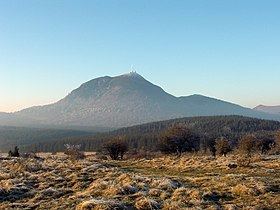Mountain type Lava dome Easiest route road Last eruption 5760 BC | First ascent Unknown Elevation 1,465 m | |
 | ||
Similar Puy de Sancy, Puy Pariou, Puy de la Vache, Puy de Côme, Puy Mary | ||
Du sancy au puy de d me la cha ne des puys vue du ciel
Puy de Dôme ([pɥi də dom]; (Auvergnat Puèi Domat, Puèi de Doma) is a large lava dome and one of the youngest volcanoes in the Chaîne des Puys region of Massif Central in central France. This chain of volcanoes including numerous cinder cones, lava domes, and maars is far from the edge of any tectonic plate. Puy de Dôme is approximately 10 kilometres (6 mi) from Clermont-Ferrand. The Puy-de-Dôme département (with hyphens) is named after the volcano.
Contents
- Du sancy au puy de d me la cha ne des puys vue du ciel
- Map of Puy de DC3B4me 63870 Orcines France
- HistoryEdit
- CyclingEdit
- TourismEdit
- References
Map of Puy de D%C3%B4me, 63870 Orcines, France
HistoryEdit
In pre-Christian Europe, Puy de Dôme served as an assembly place for spiritual ceremonies. Temples were built at the summit, including a Gallo-Roman temple dedicated to the God Mercury, the ruins of which were discovered in 1873.
In 1648, Florin Périer, at the urging of Blaise Pascal, proved Evangelista Torricelli's theory that barometric observations were caused by the weight of air by measuring the height of a column of mercury at three elevations on Puy de Dôme.
In 1875, a physics laboratory was built at the summit. Since 1956, a TDF (Télédiffusion de France) antenna is also located there.
On the top of the mountain, there is a transmitter for FM and TV.
CyclingEdit
In more recent times, Puy de Dôme has served as an occasional stage finish in the Tour de France. It was here that in 1964 Raymond Poulidor battled with Jacques Anquetil in one of the race's most famous moments, racing side by side up almost the entire climb; and that in 1975 Eddy Merckx was punched in the kidney by a spectator. According to Jean-François Pescheux, since the construction of a rack railway, and because of the very narrow road, the Tour will never come back to the Puy de Dôme, its last ascension in the race being in 1988.
The road is only open for cyclists during very limited periods (when other vehicles are prohibited). In 2006 this was 7–9am on Wednesdays and Sundays between 1 May and 30 September. In 2017, it will be the first checkpoint in the Transcontinental Race, which is a non-stop, unsupported bicycle race across Europe.
TourismEdit
The Puy de Dôme is one of the most visited sites in the Auvergne region, attracting nearly 500,000 visitors a year. It is a well-known centre for paragliding. The summit offers expansive views of the Chaîne des Puys and Clermont-Ferrand. A restaurant and shops are available, as well as a visitor centre giving information on the history and geology of the area.
A pedestrian path (Le sentier des muletiers), formerly a Roman road, leads to the Temple of Mercury. The motor road previously leading to the summit is now closed. Visitors must hike up on foot or take the Panoramique des Dômes, a rack railway operational since May 2012.
Hikers can also reach the Puy using a footpath on the northern side, which runs past the Nid de la Poule crater. The GR 4 long-distance trail uses this footpath and the sentier des muletiers to traverse the mountain.
